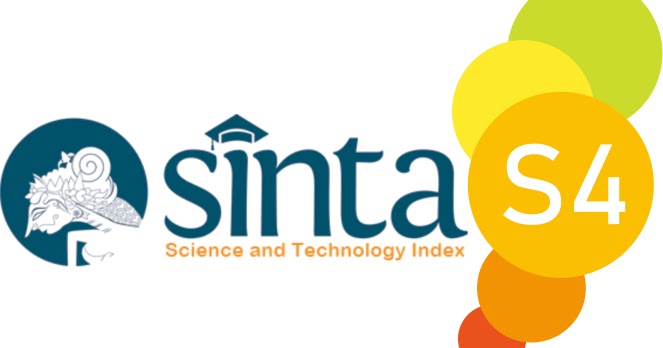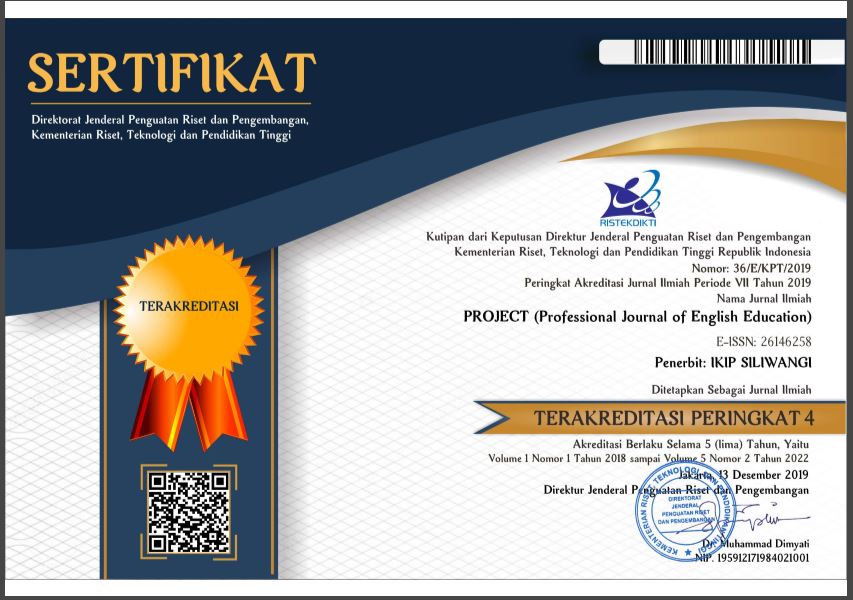The Use of Digital Multimodal Approach in Teaching English Speaking Skill
Abstract
This study investigates the development of students' English-speaking skills and self-confidence by implementing a digital multimodal presentation project in an English-speaking class. Employing a qualitative case study design, data were collected from 31 students and one English teacher through classroom observations, reflective journals, interviews, and document reviews. The findings indicate that the multimodal approach helped students improve their speaking proficiency by integrating various digital tools, fostering creativity, and reducing anxiety. However, some students faced challenges in terms of technical difficulties and limited English vocabulary. Despite these obstacles, the digital multimodal project significantly contributed to building students' self-confidence in speaking English. This method is recommended for further use to enhance students' engagement and communication skills in the language-learning process.
References
Alharbi, M. (2022). The Role of Structured Reading Activities in Enhancing English Proficiency. Journal of Language and Education Studies, 18(2), 85–100.
Arianto, A., Yusra, K., & Wahyuni, S. (2023). The Role of Self-Confidence in Enhancing Speaking Skills of EFL Learners. International Journal of Linguistics and Language Education, 9(2), 123-136.
Baker, A. (2011). Pronunciation Pedagogy and Theory: New Views, New Directions. TESOL Quarterly, 45(3), 525–536.
Bartholomew, S., & Ross, D. (2020). The Effects of Multimodal Presentation Methods on Student Confidence in Speaking Tasks. Educational Technology Research Journal, 12(3), 112–129.
Benson, P. (2011). Teaching and Researching Autonomy in Language Learning. Routledge.
Bialystok, E. (2001). Foundations of Bilingual Education and Bilingualism. Multilingual Matters.
Brown, H. D. (2019). Principles of Language Learning and Teaching (7th ed.). Pearson Education.
Chen, J. (2023). Digital Tools in Language Learning: Vocabulary Acquisition and Speaking Fluency. Journal of Educational Innovation, 5(4), 345–360.
Derwing, T. M., & Munro, M. J. (2015). Pronunciation Fundamentals: Evidence-Based Perspectives for L2 Teaching and Research. John Benjamins Publishing.
Dörnyei, Z. (2020). Motivational Strategies in the Language Classroom. Cambridge University Press.
Ericsson, K. A., Krampe, R. T., & Tesch-Römer, C. (1993). The Role of Deliberate Practice in the Acquisition of Expert Performance. Psychological Review, 100(3), 363-406.
Garcia, P., Gonzales, R., & Martinez, A. (2016). Self-Confidence and Its Impact on English Language Proficiency: A Case Study of EFL Learners. Journal of Second Language Research, 5(1), 45-58.
Heo, H., & Hwang, W. Y. (2018). Integrating Multimodal Methods in Language Learning: Impacts on Confidence and Proficiency. Journal of Interactive Learning Research, 19(2), 110-127.
Hwang, W. Y., Chen, N. S., & Chen, S. H. (2021). Enhancing Learners’ Engagement Through Visual Aids in Language Classes. Language Learning and Technology, 25(1), 43-60.
Johnson, R. (2018). Fluency and Accuracy in Language Learning: The Role of Self-Confidence. TESOL Quarterly, 52(3), 301–320.
Kern, R. (2014). Technology and Language Learning: An Overview. Language Learning & Technology, 18(2), 1–17.
Kim, H., Park, J., & Lee, S. (2021). The Role of Short Video Projects in Articulating Emotions and Developing Identity in EFL Learners. English Teaching & Learning, 45(4), 623-639.
Listyani, L., & Kristie, B. (2018). Enhancing Students' Speaking Skills Through Confidence-Building Activities in the EFL Classroom. International Journal of Language Education, 2(2), 86-100.
Liu, X., Zhou, H., & Zhang, Y. (2022). Fostering Student Autonomy Through Digital Platforms. Language Teaching Research Quarterly, 29(3), 145–160.
MacIntyre, P. D., & Gardner, R. C. (1994). The Subtle Effects of Language Anxiety on Cognitive Processing in the Second Language. Language Learning, 44(2), 283–305.
MacIntyre, P. D., & Noels, K. A. (1996). Body Language and Second Language Confidence. Journal of Language Psychology, 8(4), 365–377.
Nation, I. S. P. (2001). Learning Vocabulary in Another Language. Cambridge University Press.
Nurviyani dkk, V. H. (2022). Pedampingan Pengajaran Bahasa Inggris dengan Menggunakan Media Pembelajaran Berbasis Multimodal di Kabupaten Cianjur. GERVASI: Jurnal Pengabdian kepada Masyarakat, 478-492.
Pham, T. T., & Lim, J. H. (2022). The Impact of Visme on Creativity and Collaboration in Multimodal Language Learning in Vietnam. Asian Journal of Applied Linguistics, 9(2), 90–105.
Ranjan, P. (2021). The Role of Non-Verbal Communication in Language Learning. Asian Journal of Linguistics, 14(1), 23–45.
Rosmayanti, R., Ningsih, E., & Wahyu, T. (2023). The Correlation Between Self-Confidence and English Speaking Ability Among Islamic Secondary School Students. Asian EFL Journal, 25(4), 117-131.
Siahaan, R. Y. (2020). Pengembangan Media Pembelajaran Public Speaking Berbasis Mukltimodal Digital Pada Mata Kuliah Bahasa Indonesia . Medan: PPPS Universitas Negeri Medan.
Smith, J., & Lee, C. (2022). Multimodal Approaches in Teaching: A Guide for Educators. Educational Research, 17(3), 78–94.
Swain, M. (2000). The Output Hypothesis and Beyond: Mediating Acquisition Through Collaborative Dialogue. In J. Lantolf (Ed.), Sociocultural Theory and Second Language Learning (pp. 97–114). Oxford University Press.
Tharp, G. (2017). Collaborative Learning and Confidence in Language Acquisition. Educational Psychology Quarterly, 12(3), 187–205.
Thorne, S. L., & Payne, J. S. (2005). Evolutionary Trajectories, Internet-Mediated Expression, and Language Education. CALICO Journal, 22(3), 371–397.
Vygotsky, L. S. (1978). Mind in Society: The Development of Higher Psychological Processes. Harvard University Press.
Wang, J., Liu, Y., & Zhao, L. (2023). The Impact of Peer Feedback on Speaking Confidence in EFL Classrooms. Language Teaching Today, 20(2), 105–123.
Waring, M., & Evans, C. (2018). Foreign Language Anxiety and its Impact on Speaking Skills. International Journal of Applied Linguistics, 28(1), 73-91.
Wisudawaty, N., Anwar, T., & Fajar, I. (2015). Multimodal Approaches in Teaching EFL Speaking: Practical Insights and Challenges. Indonesian Journal of Applied Linguistics, 4(1), 88-97.
Yuniarti, R., Sari, D. N., & Hasan, M. (2022). Enhancing Speaking Skills through Digital Storytelling: Aligning Multimodal Elements with Cultural Contexts. International Journal of Language Studies, 16(3), 45-67.
Zhang, H., & Zhang, Q. (2022). Challenges in Pronunciation Learning and Teaching: A Comprehensive Review. Journal of Second Language Pronunciation, 8(2), 199–214.
Zhang, X., & Zou, W. (2023). The Effects of Multimodal Learning on Speaking Confidence: A Meta-Analysis. Educational Technology & Society, 26(1), 56–68.
Downloads
Published
Issue
Section
License

This work is licensed under a Creative Commons Attribution-ShareAlike 4.0 International License.




